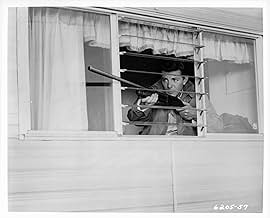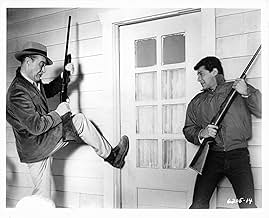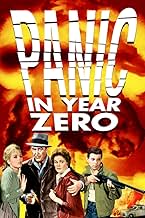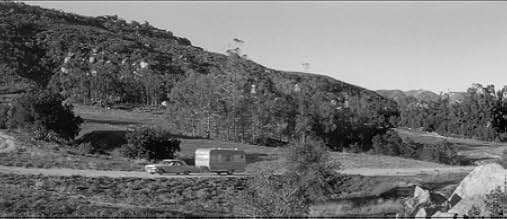AVALIAÇÃO DA IMDb
6,6/10
5,3 mil
SUA AVALIAÇÃO
Uma família sai de Los Angeles para um acampamento, pouco antes de uma bomba nuclear destruir a cidade. À medida que a cidade desce ao caos, o pai deve lutar para manter sua família viva.Uma família sai de Los Angeles para um acampamento, pouco antes de uma bomba nuclear destruir a cidade. À medida que a cidade desce ao caos, o pai deve lutar para manter sua família viva.Uma família sai de Los Angeles para um acampamento, pouco antes de uma bomba nuclear destruir a cidade. À medida que a cidade desce ao caos, o pai deve lutar para manter sua família viva.
- Direção
- Roteiristas
- Artistas
Neil Burstyn
- Andy
- (as Neil Nephew)
Chet Brandenburg
- Roadside Diner Customer
- (não creditado)
Ralph Clanton
- Radio Announcer
- (narração)
- (não creditado)
Kelton Crawford
- Looter
- (não creditado)
Avaliações em destaque
I can't say I had the greatest expectations for this low-budget post-apocalyptic thriller, directed by none other than Ray Milland. Though his career was undoubtedly in something of a downturn by the early 1960s, the Oscar-winning actor briefly found new life in the realm of B-movies, starring in Roger Corman's 'X: The Man with X-ray Eyes (1963).' The previous year, however, Milland indulged in his occasional interest in directing {in total, he has five features to his name, as well as numerous television episodes} with 'Panic in Year Zero! (1962).' Against all odds, this under-appreciated gem is among the best of its kind, somehow even managing to outclass Stanley Kramer's star-studded 'On the Beach (1959)' of three years earlier. Ever since I read Arthur Conan Doyle's "The Poison Belt" in 2007, I've wanted to make my own post-apocalyptic film, and, fascinatingly, this is exactly the sort of production I'd envisioned; sparse in action and characters, but utilising the family's isolation to bring home the terror of their predicament.
The theme of nuclear apocalypse was most common in the early 1960s, when relations between the United States and the Soviet Union were at their most hostile. Some films, such as Kubrick's 'Dr. Strangelove (1964)' and Lumet's 'Fail-Safe (1964),' chronicled the events leading up to such an incident, whereas Kramer's 'On the Beach (1959)' took place in the following months. What these big-budget offerings have in common is that they focus primarily on the big-players in the Cold War, particularly the government and military officials. 'Panic in Year Year!' deals, out of budgetary necessity more than anything else, with ordinary people in an unfathomable situation, and is all the better for it. When Harry Baldwin (Milland) takes his family on a fishing trip, the sudden flash of light emanating from Los Angeles is initially mistaken for lightning, followed by the mundane remark that "I hope it doesn't rain." The Baldwins are a regular American family who don't deserve to have their lives and lifestyles exploited like cheap pawns in a game of chess.
It's interesting that the charming rogues of the 1940s, such as Ray Milland and George Sanders, turned into convincing family-orientated men during their autumn years of acting. Milland is excellent in the main role, a dedicated father and husband who, in his determination to persevere, finds himself abandoning the very civilised morals for which he is fighting. Despite creating a strong sense of the chaos and lawlessness that accompanies a national catastrophe, the film's message is still an overwhelingly positive one: that the bonds of family and friendship are a crucial necessity in difficult times. There are, of course, a few unlikely plot turns by coincidence, the two groups of people who seek refuge in the Baldwins' hideaway are the very two with whom the family had had previously altercations and the occasional moment that can only be described as B-movie silliness {my favourite is the announcement that the sole outcome of an urgent United Nations meeting was to give this year a dramatic-sounding name}. Even so, 'Panic in Year Zero!' is a gripping and unforgettable addition to the science-fiction genre.
The theme of nuclear apocalypse was most common in the early 1960s, when relations between the United States and the Soviet Union were at their most hostile. Some films, such as Kubrick's 'Dr. Strangelove (1964)' and Lumet's 'Fail-Safe (1964),' chronicled the events leading up to such an incident, whereas Kramer's 'On the Beach (1959)' took place in the following months. What these big-budget offerings have in common is that they focus primarily on the big-players in the Cold War, particularly the government and military officials. 'Panic in Year Year!' deals, out of budgetary necessity more than anything else, with ordinary people in an unfathomable situation, and is all the better for it. When Harry Baldwin (Milland) takes his family on a fishing trip, the sudden flash of light emanating from Los Angeles is initially mistaken for lightning, followed by the mundane remark that "I hope it doesn't rain." The Baldwins are a regular American family who don't deserve to have their lives and lifestyles exploited like cheap pawns in a game of chess.
It's interesting that the charming rogues of the 1940s, such as Ray Milland and George Sanders, turned into convincing family-orientated men during their autumn years of acting. Milland is excellent in the main role, a dedicated father and husband who, in his determination to persevere, finds himself abandoning the very civilised morals for which he is fighting. Despite creating a strong sense of the chaos and lawlessness that accompanies a national catastrophe, the film's message is still an overwhelingly positive one: that the bonds of family and friendship are a crucial necessity in difficult times. There are, of course, a few unlikely plot turns by coincidence, the two groups of people who seek refuge in the Baldwins' hideaway are the very two with whom the family had had previously altercations and the occasional moment that can only be described as B-movie silliness {my favourite is the announcement that the sole outcome of an urgent United Nations meeting was to give this year a dramatic-sounding name}. Even so, 'Panic in Year Zero!' is a gripping and unforgettable addition to the science-fiction genre.
Ray Milland directs and stars in this gritty, cold war tale of a family trying to survive in the mountains after a nuclear war. Milland emphasises an 'everyone for themselves' survival ethic as his character struggles to keep his family alive at the expense of anyone who stands in his way. The movie was a low-budget project, so don't expect to see vistas of destroyed cities (you see one distant mushroom cloud) or any massive military presence (you see one jeep), but despite the cost-cutting "Panic in the Year Zero" is an effective early entry into the post-apocalyptic genre. Although mostly bloodless (a person shot at close range with a shotgun just hugs himself and topples over), the film is quite adult, with several cold-blood killings (on and off screen) and rapes (all off screen). The jazz music score, which is dated and excessive at times, detracts from the bleak tone of the movie, and the ending, while likely 'realistic', may not be a good match for some modern viewers' worldviews. Worth watching, even if only as only a celluloid relic of the cold-war.
Los Angeles family vacation is interrupted by nuclear war. Now they must escape into the mountains to avoid the radiation, the panic, and the rapists.
Despite the insipid nuclear holocaust effects (looks more like a thunderstorm), this is a surprisingly effective movie. Milland elicits effective performances from each and every member of his cast (Frankie Avalon has never been better). The menace, humiliation and sheer terror of rape has never been more poignantly depicted on the screen, and all without nudity. A minor classic.
Despite the insipid nuclear holocaust effects (looks more like a thunderstorm), this is a surprisingly effective movie. Milland elicits effective performances from each and every member of his cast (Frankie Avalon has never been better). The menace, humiliation and sheer terror of rape has never been more poignantly depicted on the screen, and all without nudity. A minor classic.
This is a genuinely enjoyable example of a "post-nuclear holocaust survival
film." It may seem a bit campy by modern standards, but is actually well thought- out and acted. The early 60's were an era in which it seemed possible to
contemplate a nuclear war that broke down civilization's normal function
withOUT reducing the entire countryside to rubble. A man takes his family out into the country to escape the chaos, still clinging to the hope that normalcy and order will soon return. His wife is horrified at his newfound ruthlessness, and the kids seem willing to go with the new rules of the jungle.
Ray Milland was at one time an acclaimed actor, but his academy award for
"Lost Weekend" seems to have cursed his career. Now regarded as a "serious"
actor, suited only for "down" roles, he wasn't given much chance to work in the more "up" big-studio roles of the fifties. By the time he wound up at AIP, he was little more than a "has-been" to the public. But he retained real talent, as his directing and starring in this and other Sci-fi pictures of the period shows. When given a free hand, as in "Panic In Year Zero!" he took on challenges others
would have shied away from and showed that he still had a lot to offer. Sadly, big time directors continued to ignore him and the end of his life was defined by roles in "Frogs" and "The Thing With Two Heads" - films far worse than anything with Corman's name on them.
"Panic in Year Zero!" displays the basic conflict of compromise: Ray's character must compromise his beliefs and code of behavior in order to preserve what he cares for. His constant conflict with his wife displays the conflict between
differing ideas of what needs to be preserved - to her, saving the family by acts of savagery is unacceptable, and the only way to preserve civilization is to apply its rules in every situation. The ending seems to redeem Ray, but the fact is that the questions raised are answered by each viewer in the course of the film in his or her own way. Events in the film are not one-sided, and Ray's relation to the hardware store owner calls into question his position and correctness: perhaps by allying himself earlier with other decent people trying to survive, Ray could have saved his family from some of what it endures.
As we now re-acclimate ourselves to an era in which the possibility of "limited" nuclear attack (from national or independent terrorist groups) seems more likely than Mutual Assured Destruction, it is possible that films such as "Panic in Year Zero!" offer us important ethical problems. Problems we hope never to have to solve in real life, but which the screen offers a means to wrestle with in a safe environment.
film." It may seem a bit campy by modern standards, but is actually well thought- out and acted. The early 60's were an era in which it seemed possible to
contemplate a nuclear war that broke down civilization's normal function
withOUT reducing the entire countryside to rubble. A man takes his family out into the country to escape the chaos, still clinging to the hope that normalcy and order will soon return. His wife is horrified at his newfound ruthlessness, and the kids seem willing to go with the new rules of the jungle.
Ray Milland was at one time an acclaimed actor, but his academy award for
"Lost Weekend" seems to have cursed his career. Now regarded as a "serious"
actor, suited only for "down" roles, he wasn't given much chance to work in the more "up" big-studio roles of the fifties. By the time he wound up at AIP, he was little more than a "has-been" to the public. But he retained real talent, as his directing and starring in this and other Sci-fi pictures of the period shows. When given a free hand, as in "Panic In Year Zero!" he took on challenges others
would have shied away from and showed that he still had a lot to offer. Sadly, big time directors continued to ignore him and the end of his life was defined by roles in "Frogs" and "The Thing With Two Heads" - films far worse than anything with Corman's name on them.
"Panic in Year Zero!" displays the basic conflict of compromise: Ray's character must compromise his beliefs and code of behavior in order to preserve what he cares for. His constant conflict with his wife displays the conflict between
differing ideas of what needs to be preserved - to her, saving the family by acts of savagery is unacceptable, and the only way to preserve civilization is to apply its rules in every situation. The ending seems to redeem Ray, but the fact is that the questions raised are answered by each viewer in the course of the film in his or her own way. Events in the film are not one-sided, and Ray's relation to the hardware store owner calls into question his position and correctness: perhaps by allying himself earlier with other decent people trying to survive, Ray could have saved his family from some of what it endures.
As we now re-acclimate ourselves to an era in which the possibility of "limited" nuclear attack (from national or independent terrorist groups) seems more likely than Mutual Assured Destruction, it is possible that films such as "Panic in Year Zero!" offer us important ethical problems. Problems we hope never to have to solve in real life, but which the screen offers a means to wrestle with in a safe environment.
Sure it didn't have a huge budget or major-league stars, but it's a bleak and realistic little drama that has an authentic tone and a sense of desperation that feels utterly genuine. There's undoubtedly a "you-had-to-be-there" reaction that I had to it, being from Los Angeles and knowing the mountain area and easily being able to imagine seeing that mushroom cloud in my own mind. I was eight when this originally came out -- not sure if I saw it in the theater but it's possible -- and that creepy Conalrad radio tone is still in my head after all these years.
Nobody -- except maybe Charlton Heston -- can look quite so anguished and masculine and bearing-the-weight-of-the-world-on-his-shoulders-in-the-face-of-civilization 's-downfall as Ray Milland does in this movie.
It looks like we dodged the nuclear war bullet back in the 1960s, but I'm sure that anybody living today can still identify with the terrifying prospect of a devastating nuclear war and what could happen if you were one of the lucky/unlucky survivors. This may not be "The Day After" but it's a plucky low-budget version of the same theme and worth seeing alongside other 60s nuclear nightmare movies.
Nobody -- except maybe Charlton Heston -- can look quite so anguished and masculine and bearing-the-weight-of-the-world-on-his-shoulders-in-the-face-of-civilization 's-downfall as Ray Milland does in this movie.
It looks like we dodged the nuclear war bullet back in the 1960s, but I'm sure that anybody living today can still identify with the terrifying prospect of a devastating nuclear war and what could happen if you were one of the lucky/unlucky survivors. This may not be "The Day After" but it's a plucky low-budget version of the same theme and worth seeing alongside other 60s nuclear nightmare movies.
Você sabia?
- CuriosidadesWhen the family is in the car at the beginning of the film and suspect something is happening, they cannot pick up any "CONELRAD" stations on the car's radio. CONELRAD (COntrol of ELectromagnetic RAdiation), established in 1951, was the first nationwide system for emergency broadcasts in the United States. All radios made between 1953 and 1963 were required to have marks on the AM dial at 640 and 1240 MHz where citizens were expected to tune to obtain civil defense information. CONELRAD was succeeded by the Emergency Broadcast System in 1963 (which did not use dedicated frequencies) and it, in turn, was replaced by the Emergency Alert System in 1997.
- Erros de gravaçãoIn the scene where the bridge is pulled down, to the left you can see bushes and the bridge pilings being pulled quickly in the opposite direction.
- Citações
Dr. Powell Strong: Now, you stay on the back roads. And you keep your gun handy. Our country is still full of thieving, murdering... "patriots."
- Cenas durante ou pós-créditosOther than the title, all credits are at the end of the movie.
- ConexõesFeatured in Aweful Movies with Deadly Earnest: Panic in the Year Zero (1969)
Principais escolhas
Faça login para avaliar e ver a lista de recomendações personalizadas
- How long is Panic in Year Zero!?Fornecido pela Alexa
Detalhes
- Data de lançamento
- País de origem
- Idioma
- Também conhecido como
- ¿Habrá otro mañana?
- Locações de filme
- Empresa de produção
- Consulte mais créditos da empresa na IMDbPro
Bilheteria
- Orçamento
- US$ 225.000 (estimativa)
- Tempo de duração
- 1 h 33 min(93 min)
- Cor
- Mixagem de som
- Proporção
- 2.35 : 1
Contribua para esta página
Sugerir uma alteração ou adicionar conteúdo ausente
























